
The East Asian hip-and-gable roof (Xiēshān (歇山) in Chinese, Paljakjibung (팔작지붕) in Korean and Irimoya (入母屋) in Japanese) also known as 'resting hill roof', consists of a hip roof that slopes down on all four sides and integrates a gable on two opposing sides.[2][3] It is usually constructed with two large sloping roof sections in the front and back respectively, while each of the two sides is usually constructed with a smaller roof section.[4]
The style is Chinese in origin, and has spread across much of East and Continental Asia. The original Chinese style and similar styles are not only found in the traditional architectures of Japan and Korea but also other Continental Asian countries such as India, Vietnam, Mongolia, Tibet, Nepal, Sri Lanka and Kalmykia. A similar, generally taller and originally thatched hip and gable style is also traditionally used in Southeast Asia such as in the Philippines and in Indonesia.
Etymology
It is known as xiēshān (歇山) in Chinese,[5][6] paljakjibung (팔작지붕; 八作--) in Korean.[7] and irimoya (入母屋) in Japanese,[3]
East Asia
Xieshan in China
In China, the hip-and-gable roof style, also known as the xieshan roof style, originated in the Eastern Han dynasty as an adaptation of the hip roof. It was mainly applied in the construction of palaces, temples, gardens and other buildings with official functions. In contemporary times, it is still widely used in Buddhist and Taoist temples and shrines in China.[8]
The style is generally characterized by the presence of nine ridges and a hipped roof encircled with a peristyle. The nine ridges typically consists of one horizontal ridge on the top, known as the main ridge, which is connected to four vertical ridges and four diagonal ridge.
There are typically two types of eaves associated with the xieshan style: single eaves (单檐) and double eaves (重檐). Single eaves refer to the edges of a basic xieshan rooftop, while double eaves consist of an additional layer of eaves below the basic xieshan rooftop. Examples of the double eave type can be found on the xieshan roofs of structures such as Cining Palace, the Gate of Supreme Harmony and the Hall of Preserving Harmony in the Forbidden City, as well as the Grand Hotel in Taipei. Examples of the single eave type can be found on buildings such as Zhihua Temple, the shanmen of Miaoying Temple, and the North Gate of the Walls of Taipei.
Irimoya in Japan
Irimoya arrived from China to Japan in the 6th century.[3] The style was originally used in the main and lecture halls of a Buddhist temple compound. It started to be used for the honden at shrines and also in palaces, castles, and folk dwellings later during the Japanese Middle Ages.[9] Its gable is usually right above the moya, or core, while the hip covers the hisashi, a veranda-like aisle surrounding the core on one or more sides.[3]
It is still in wide use in the construction of Buddhist temples and Shinto shrines in Japan. It is also often called moya-zukuri (母屋造).[3] Another variant of Japanese hip-and-gable roof is the Shikorobuki.
South Asia
Kandyan roof of Sri Lanka
In Sri Lanka, a style known as the kandyan roof bears many similarities to the original East Asian hip-and-gable roof. The kandyan roof is primarily used for religious, and historically, royal buildings. Its roots however lie in the traditions of the "Sri Lankan village".[10][11]
Gallery

 Xieshan roof with multiple eaves on the Mahavira Hall of Xiantong Temple on Mount Wutai, Wutai County, Shanxi, China
Xieshan roof with multiple eaves on the Mahavira Hall of Xiantong Temple on Mount Wutai, Wutai County, Shanxi, China Xieshan roof with single eaves on the Hall of the Three Pure Ones in Xuanmiao Temple in Suzhou, Jiangsu, China
Xieshan roof with single eaves on the Hall of the Three Pure Ones in Xuanmiao Temple in Suzhou, Jiangsu, China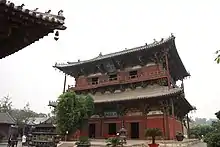
 One of the oldest existing structure exhibiting a Xieshan roof — The Great Buddha Hall in Nanchan Temple on Mount Wutai, Wutai County, Shanxi, China, dating back to the Tang dynasty (618-907).
One of the oldest existing structure exhibiting a Xieshan roof — The Great Buddha Hall in Nanchan Temple on Mount Wutai, Wutai County, Shanxi, China, dating back to the Tang dynasty (618-907).
.jpg.webp)
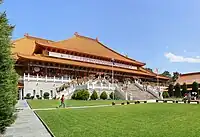
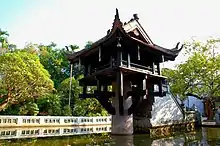 One Pillar Pagoda in Hanoi
One Pillar Pagoda in Hanoi
 Yakushi-ji's (Dai)kō-dō
Yakushi-ji's (Dai)kō-dō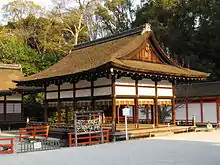 A hip-and-gable roof at Shimogamo Shrine
A hip-and-gable roof at Shimogamo Shrine A shikoro-yane
A shikoro-yane Shitennō-ji main gate and its shikoro-yane
Shitennō-ji main gate and its shikoro-yane The Tamamushi Shrine has a shikoro-yane
The Tamamushi Shrine has a shikoro-yane A haiden of Shinto shrine in East Asian Hip-and-Gable roof style architecture.
A haiden of Shinto shrine in East Asian Hip-and-Gable roof style architecture.
 The Kandyan roof style of the Temple of the Tooth in Kandy, Sri Lanka
The Kandyan roof style of the Temple of the Tooth in Kandy, Sri Lanka The Great Drigung Kagyud Lotus Stupa in Lumbini, Nepal
The Great Drigung Kagyud Lotus Stupa in Lumbini, Nepal The Mahamevnawa Buddhist Monastery in Polgahawela, Sri Lanka
The Mahamevnawa Buddhist Monastery in Polgahawela, Sri Lanka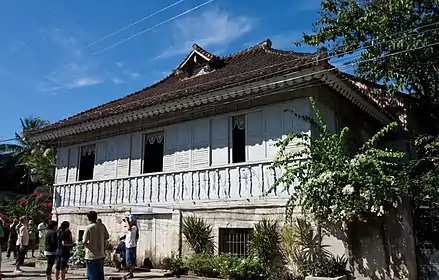 A Bahay na bato in Cebu, Philippines
A Bahay na bato in Cebu, Philippines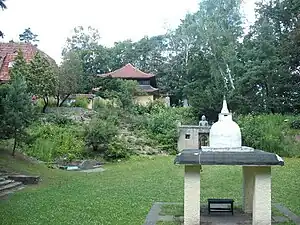
 Iringol Kavu Temple, Kerala, India
Iringol Kavu Temple, Kerala, India Mannar Thrikkuratti Mahadeva Temple, Kerala, India
Mannar Thrikkuratti Mahadeva Temple, Kerala, India Padmanabhapuram Palace, Kerala, India
Padmanabhapuram Palace, Kerala, India Sree Madiyan Koolom Kshethrapalaka Temple, Kerala, India
Sree Madiyan Koolom Kshethrapalaka Temple, Kerala, India
See also
References
- ↑ Chung, Anita (2004). Drawing boundaries : architectural images in Qing China. Honolulu: Univ. of Hawai'i Press. pp. 23–24. ISBN 9780824826635.
- ↑ Guo, Qinghua (2010). The mingqi pottery buildings of Han Dynasty China, 206 BC-AD 220 : architectural representations and represented architecture. Brighton: Sussex Academic Press. p. 138. ISBN 9781845193218.
- 1 2 3 4 5 "Irimoya-zukuri". JAANUS: Japanese Architecture and Art Net Users System. Retrieved 2009-05-31.
- 1 2 Deqi, Shan (25 August 2011). Chinese vernacular dwellings. Cambridge: Cambridge University Press. pp. 11–12. ISBN 9780521186674.
- ↑ Chen, Congzhou; Pan, Hongxuan; Lu, Bingjie (2008). Chinese houses : a pictorial tour of China's traditional dwellings. Pleasantville: Reader's Digest Association. p. 331. ISBN 9781606520017.
- ↑ Chung, Anita (2004). Drawing boundaries : architectural images in Qing China. Honolulu: Univ. of Hawai'i Press. pp. 23–24. ISBN 9780824826635.
- ↑ "Naver Dictionary". Retrieved 2013-03-10.
- ↑ Li, Xianda; liu, Yu (April 2017). "The "shape" and "meaning" of the roof arts in Chinese classical architecture". IOP Conference Series: Earth and Environmental Science. 61: 012110. doi:10.1088/1755-1315/61/1/012110. ISSN 1755-1307.
- ↑ Iwanami Nihonshi Jiten (岩波日本史辞典), CD-ROM Version. Iwanami Shoten, 1999-2001.
- ↑ Herrle, Peter; Wegerhoff, Erik (2008). Architecture and Identity. LIT Verlag Münster. ISBN 978-3-8258-1088-7.
- ↑ Paranavitana, Senarat; Prematilleka, Leelananda; Leeuw, Johanna Engelberta van Lohuizen-De (1978). Senarat Paranavitana Commemoration Volume. BRILL. ISBN 978-90-04-05455-4.
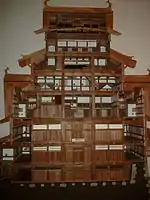
.svg.png.webp)
